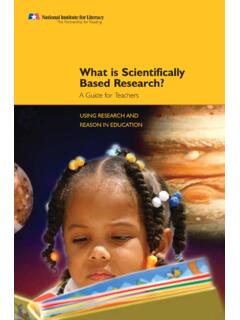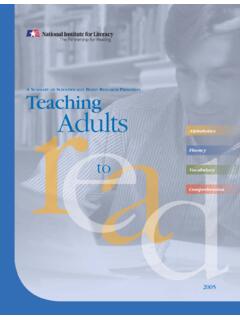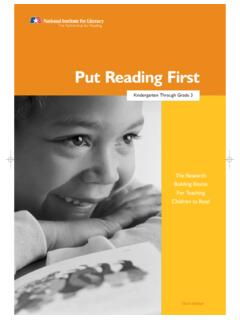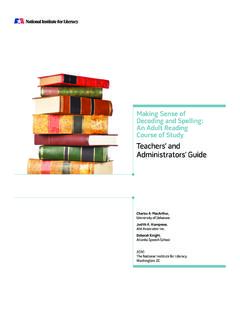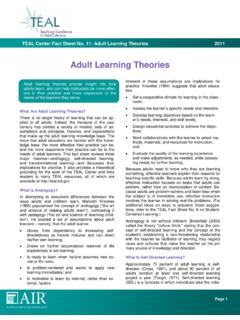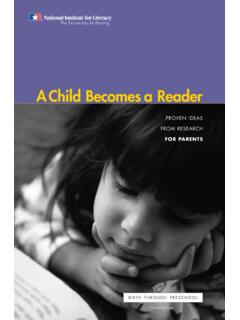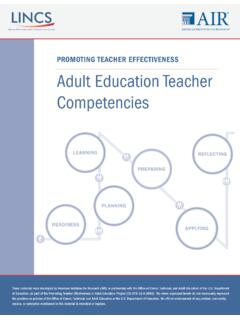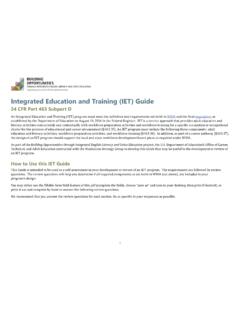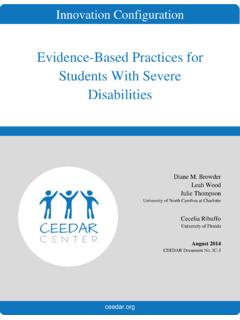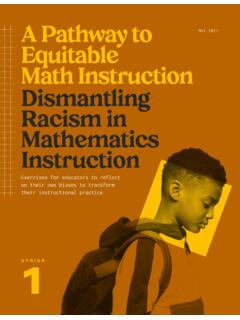Transcription of What Is Evidence-Based Reading Instruction and How Do …
1 What Is Evidence-Based Reading Instruction and How Do You Know It When You See It? Kit Bell & Stephen Dolainski Division of Adult and Career Education, Los Angeles Unified School District As teachers and programs become more capable of applying research- based principles for Reading assessment and Instruction , the real winners should be adult learners and their families. Improved literacy skills may allow these adults to take giant steps in the journey of lifelong learning.. Susan McShane First Steps for Teachers, 2005. Department of Education Office of Vocational and Adult Education This report was produced under Department of Education Contract No. ED-VAE-09-C-0042, with Barrera Associates, Inc. Sheryl Adler served as the contracting officer's representative. Mention of trade names, com- mercial products, or organizations in this report does not imply endorse- ment by the government. This publication also contains URLs for information created and maintained by private organizations.
2 This infor- mation is provided for the reader's convenience. The Department of Education is not responsible for controlling or guaranteeing the accuracy, relevance, timeliness, or completeness of this outside information. Fur- ther, the inclusion of information or URLs does not reflect the importance of the organization, nor is it intended to endorse any views expressed. Department of Education Arne Duncan Secretary of Education Office of Vocational and Adult Education Brenda Dann-Messier Assistant Secretary Division of Adult Education and Literacy Cheryl Keenan Director March 2012. This report is in the public domain. Authorization to reproduce it in whole or in part is granted. While permission to reprint this publication is not necessary, the citation should be: Department of Education, Office of Vocational and Adult Education, Adult Education Great Cities Summit: What Is Evidence-Based Reading Instruction and How Do You Know It When You See It?
3 Washington, DC, 2012. This report is available on the Department's website at: On request, this publication is available in alternative formats, such as Braille, large print or CD. For more information, please contact the Department's Alternate Format Center at 202-260-0852 or 202-260-0818. What Is Evidence-Based Reading Instruction and How Do You Know It When You See It? Introduction T he Division of Adult and Career Education (DACE) of the Los Angeles Unified School District (LAUSD) is the largest provider of Reading Instruction to adults in the greater Los Angeles area. DACE operates within the 710 square miles that comprise the LAUSD. In the 2010-2011 school year, more than 12,000 adult and young adult learners enrolled in Adult Basic Education (ABE) Reading classes offered by DACE and taught by 173. instructors at more than 30 campuses throughout the District. Efforts began in 2005 to introduce Evidence-Based Reading Instruction (EBRI) to DACE teachers and administrators.
4 Since then, implementing EBRI in DACE ABE Reading classes has been a work in progress. It continues today as more teachers are trained. Implementing EBRI requires fundamental change both in perceptions of what constitutes adult Reading Instruction and how adult education programs deliver that Instruction . This brief reflects the experience of the LAUSD's ABE. Program as it has worked to bring about these fundamental changes. Part I defines and describes Evidence-Based Reading Instruction . Part II offers examples of instructional scenarios that demonstrate what EBRI looks like in the classroom. Part III is a brief case study of how EBRI has been imple- mented within LAUSD. Part IV offers recommendations to agencies that may wish to implement EBRI. Part I: What Is Evidence-Based Reading Instruction ? Any discussion of Evidence-Based Reading Instruction should begin with a definition of Reading and a clarification of what the term Evidence-Based means.
5 The Partnership for Reading (National Institute for Literacy, 2005) defines Reading as a complex system of deriving meaning from print. It requires: - an understanding of how phonemes, or speech sounds, are connected to print - the ability to decode unfamiliar words - the ability to read fluently - sufficient background information and vocabulary to foster Reading comprehension - the development of appropriate active strategies to construct meaning from print - the development and maintenance of a motivation to read ( Reading Excellence Act;. retrieved Oct. 9, 2011; ). Evidence-Based refers to practices that have been shown to be successful in improving Reading achievement. The success of these practices is demonstrated in two ways: by research-study data collected according to rigorous design, and by consensus among expert practitioners who monitor outcomes as part of their practice. These results whether scientific data or expert consensus must be valid and reliable and come from a variety of sources ( Reading Excellence Act, 1999).
6 A summary of scientifically- based findings is found in Adult Education Literacy Instruction : A Review of the Re- search (Kruidenier, MacArthur, & Wrigley, 2010). It is a follow-up to Research- based Principles for Adult Basic Education Reading Instruction (Kruidenier, 2005). Applying Research in Reading Instruction for Adults: First Steps for Teachers (McShane, 2005) presents the consensus among experts about the implications of this research for Instruction . 3 Adult Education Great Cities Summit What Is Evidence-Based Reading Instruction and How Do You Know It When You See It? The research produced findings that together form the basis of Evidence-Based practices. Among them: - There are four key component areas of Reading : alphabetics (phonemic awareness, phonics, decoding), fluency (the ability to read accurately, at an appropriate rate, and with prosody), vocabulary, and comprehension. - Learners' strengths and weaknesses need to be assessed in each of the four components.
7 - Instruction should be based on assessment results. - Instruction should be systematic, sequenced, direct, and explicit. - Instruction and materials need to be engaging and relevant to learners' needs. - Instruction must be continuously monitored, by teacher and learners, to gauge its effectiveness. The research suggests that effective adult Reading in- struction is more nuanced than traditionally delivered in most adult basic education classrooms. For example, most, if not all, instructional decisions generally have been based on a single assessment, specifically a silent Reading comprehension test, such as TABE. The research, however, tells us that a single assessment provides an in- complete picture of a learner's strengths and weaknesses. It is critical to assess a student's strengths and weaknesses in all components for the simple reason that the strengths and weaknesses a student exhibits in one component affect his or her ability in the other components.
8 Multiple assessments provide more instructionally relevant infor- mation about a learner's needs (Kruidenier, MacArthur, &. Wrigley, 2010). For example, a student who is not a fluent reader will likely have difficulty comprehending much of what he or she is Reading . The poor comprehension is in part due to the lack of fluency. Helping a non-fluent reader to improve his or her fluency skills will also help raise that student's comprehension level. A key concept of EBRI is teach the reader, not the Reading . In other words, the focus of evidenced- based in- struction is not to have students master content area subject matter; rather, EBRI focuses on helping students master Reading strategies that build Reading skill. For example, when the student learns the comprehension strategy of summarizing, he or she transfers it to another situation, thereby allowing the student to make meaning from a variety of texts.
9 Similarly, vocabulary Instruction should focus on the corpus of high-utility, high-frequency words that learners will find useful in many contexts (National Reading Panel, 2000). These are often referred to as Tier 2 Words (Beck &. McKeown, 1985). Words such as analyze, recognize, and transform have numerous applications, and students will encounter them in a wide range of materials across content areas. Spending precious class time teaching special- ized words like metamorphosis or scythe is counterproductive when it comes to building a rich, useful vocabulary. These content-area words can be explained at the time they are encountered in a text (Beck et al., 2002). That is not to say that content-related materials should not be introduced into an EBRI classroom. One of the purposes of assessment is to determine a student's mastery and instructional levels in the component areas. Content- or job-related materials have a place in an EBRI classroom as long as they are at the appropriate levels for the students who will be using them.
10 4 Adult Education Great Cities Summit What Is Evidence-Based Reading Instruction and How Do You Know It When You See It? Part II: How Do You Know EBRI When You See It? Scenario A. It is several weeks into the school term. In an adult Reading classroom, three groups of ABE students are observed working at tables. The teacher is providing Instruction in alphabetics to four students in Group A. Six to eight students each comprise Groups B and C. These groups are using a graphic organizer to practice the comprehension strategy of summarizing. Group B is using material written at about a fifth-grade level. Group C is practicing with seventh-grade level material. At some point the teacher leaves Group A to monitor Groups B and C and provide feedback to the students. Finally, the teacher asks all students to complete what they are doing. Twenty to twenty-five minutes have been devoted to this portion of the class.
